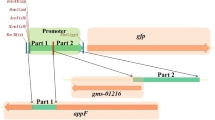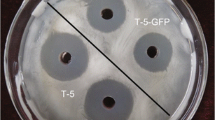Abstract
Bacillus subtilis B96-II is a broad-spectrum biological control strain. It effectively suppresses soil-borne fungal diseases in vegetables. A green fluorescence protein (GFP) was expressed in B96-II to detect migration of B96-II into the root and stem of asparagus. The GFP-tagged B96-II (B96-II-GFP) strain exhibited bright green fluorescence under a fluorescence microscope. GFP was stable and had no apparent effects on the growth of the strain. Asparagus plants were planted in the soil inoculated with B96-II-GFP. Our results showed that B96-II-GFP was detected in both the root and stem 15, 30, and 45 days after the asparagus seedlings were planted. B96-II-GFP was also detected in leaves but at a lower concentration. The highest concentration was detected in 15 days, and the number of bacteria decreased subsequently irrespective of duration of growth or sampling period. The highest concentration of B96-II-GFP was present in the root base suggesting that the root base served as the hub of bacterial migration from the soil to the stem.


Similar content being viewed by others
References
Arriola LL (1997) Arbuscular mycorrhizal fungi and Trichoderma harzianum in relation to border cell production and Fusarium root rot of asparagus. Michigan State University
Blok WJ, Zwankhuizen MJ, Bollen GJ (1997) Biological control of Fusarium oxysporum f. sp. asparagi by applying non-pathogenic isolates of F. oxysporum. Biocontrol Sci Techn 7:527–542
de Weger LA, Kuiper I, van der Bij AJ et al (1997) Use of a lux-based procedure to rapidly visualize root colonisation by Pseudomonas fluorescens in the wheat rhizosphere. Antonie Van Leeuwenhoek 72(4):365–372
Di Lenna P, Foletto B (1989) Effect of nursery management on subsequent Fusarium decline of asparagus in field. In: VIIth international asparagus symposium, p 271
Elmer WH (2001) Fusarium diseases of asparagus. Nelson Memorial Symposium. APS Press, St Paul
Farr DF, Bills GF, Chamuris GP et al (1989) Fungi on plants and plant products in the United States. APS press, St Paul
James EK, Gyaneshwar P, Mathan N et al (2002) Infection and colonization of rice seedlings by the plant growth-promoting bacterium Herbaspirillum seropedicae Z67. Mol Plant Microbe Interact 15(9):894–906
Larkin RP, Hopkins DL, Nartin FN (1996) Suppression of Fusarium wilt of watermelon by nonpathogenic Fusarium oxysporum and other microorganisms recovered from disease-suppressive soil. Phytopathol 86:812–819
Liu X, Zhao H, Chen S (2006) Colonization of maize and rice plants by strain Bacillus megaterium C4. Curr Microbiol 52(3):186–190
Ma LP, Gao F, Qiao XW (1999) Efficacy of compost extracts to cucumber wilt (Fusarium oxysporum f. sp. cucumerium) and its mechanisms. Acta Phytopathol Sin 29:70–274
Ma LP, Hao BQ, Qin S et al (2008) Casual study on inhibition effects of antagonistic Bacillus strain B96-II to Asparagus stem blight. Acta Agr Bor Sin 23:180–184
Ma LP, Qiao XW, Gao F et al (2006) Inhibition effects of antagonist strain B96-II to different Fusarium wilt and its main inhibiting substance. Acta Agr Bor Sin 21:99–102
Mandeel Q, Baker R (1991) Mechanisms involved in biological control of Fusarium wilt of cucumber with strains of nonpathogenic Fusarium oxysporum. Phytopathology 81(4):462–469
Martínez L, Caballero-Mellado J, Orozco J et al (2003) Diazotrophic bacteria associated with banana (Musa spp.). Plant Soil 257(1):35–47
Martin FN, Loper JE (1999) Soilborne plant diseases caused by Pythium spp.: ecology, epidemiology, and prospects for biological control. Crit Rev Plant Sci 18(2):111–181
Misaghi I, Donndelinger C (1990) Endophytic bacteria in symptom-free cotton plants. Phytopathology 80(9):808–811
Normander B, Hendriksen NB, Nybroe O (1999) Green fluorescent protein-marked Pseudomonas fluorescens: localization, viability, and activity in the natural barley rhizosphere. Appl Environ Microbio 65(10):4646–4651
Pontaroli AC, Camadro EL (2005) Somaclonal variation in Asparagus officinalis plants regenerated by organogenesis from long-term callus cultures. Genet Mol Biol 28(3):423–430
Reiter B, Pfeifer U, Schwab H et al (2002) Response of endophytic bacterial communities in potato plants to infection with Erwinia carotovora subsp. atroseptica. Appl Environ Microbiol 68(5):2261–2268
Shaw JJ, Dane F, Geiger D et al (1992) Use of bioluminescence for detection of genetically engineered microorganisms released into the environment. Appl Environ Microbio 58(1):267–273
Simons M, Van Der Bij AJ, Brand I et al (1996) Gnotobiotic system for studying rhizosphere colonization by plant growth-promoting Pseudomonas bacteria. MPMI-Mol Plant Microbe Interact 9(7):600–607
Stephens C, De Vries R, Sink K (1989) Evaluation of Asparagus species for resistance to Fusarium oxysporum f. sp. asparagi and F. moniliforme. HortScience 24(2):365–368
Suhaida S, NurAinIzzati MZ (2013) The efficacy of Trichoderma harzianum T73s as a biocontrol agent of fusarium ear rot disease of maize. Int J Agric Biol 15:1175–1180
Unge A, Jansson J (2001) Monitoring population size, activity, and distribution of gfp-luxAB-tagged Pseudomonas fluorescens SBW25 during colonization of wheat. Microb Ecol 41(4):290–300
Weller DM, Thomashow LS, Cook RJ (1995) Biological control of soil-borne pathogens of wheat: benefits, risks and current challenges. Cambridge University, Cambridge
Winter M, Koopmann B, Döll K et al (2013) Mechanisms regulating grain contamination with trichothecenes translocated from the stem base of wheat (Triticum aestivum) infected with Fusarium culmorum. Phytopathology 103(7):682–689
Wong J, Jeffries P (2006) Diversity of pathogenic Fusarium populations associated with asparagus roots in decline soils in Spain and the UK. Plant Pathol 55(3):331–342
Zhu P, Wu L, Liu L et al (2013) Fusarium asiaticum: an emerging pathogen jeopardizing postharvest asparagus spears. J Phytopath 161(10):696–703
Zhuge J (2005) The experiment technology of modern fermentation by microorganisms. Chemical Industry Press, BeiJing
Acknowledgments
This research was funded by Shanxi Provincial Natural Science Foundation for Youth under Grant [2007021037] and Shanxi Provincial Natural Science Foundation under Grant [2012011046-4].
Author information
Authors and Affiliations
Corresponding author
Ethics declarations
Conflict of interest
None.
Rights and permissions
About this article
Cite this article
Hao, BQ., Ma, LP. & Qiao, XW. Quantitative Analysis of the Migration and Accumulation of Bacillus subtilis in Asparagus officinalis . Curr Microbiol 71, 357–362 (2015). https://doi.org/10.1007/s00284-015-0865-z
Received:
Accepted:
Published:
Issue Date:
DOI: https://doi.org/10.1007/s00284-015-0865-z




